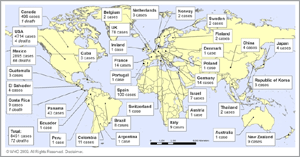Introduction: The swine influenza A virus (H1N1) has in the recent days infected humans in USA, Mexico, European countries and some Far East countries. (Cannell et al, 2006).
Causes: The swine influenza virus can be spread from pigs to humans and humans to humans. Pig to human infection is most likely to occur when close contact with infected pigs occurs such as in pig barns. The virus is spread through coughing and sneezing.
Clinical Manifestation: The swine flu virus infection manifests with sudden and elevated fever, cough, sore throat, respiratory illnesses such as nasal congestion and rhinorrhea. Other symptoms include nausea, severe vomiting and diarrhea, anorexia headache, chills, fatigue, myalgia and dyspnea (WHO, 2008).
Treatment, Management and Prevention: This virus is very sensitive to antiviral agents such as Oseltamivir (Tamiflu) and Zanamivir (Relenza). Prevention may include early detection so that its spread is controlled, killing and avoiding of infected pigs, quarantining of infected persons until they are declared safe to mingle with others, and use of face masks to prevent inhalation of the virus from the air. Hand washing and personal hygiene is also very important (Commonwealth of Australia 2009).
Epidemiology of Swine Flu Virus: The recent swine flu virus was first detected in Mexico in March, 2009 where it caused 159 deaths and 2,498 illnesses. The virus was also reported in United States, Canada, Britain, Spain, and New Zealand and Israel.
Outbreak effects on my Community: Swine flu virus infection can have varied impacts in the community in terms of health, socioeconomic and psychological effects. Initially, the monitoring and surveillance of this infection needs huge amounts of money to be effectively and efficiently carried out.
Secondly, the infection has severe consequences on human health ranging from mild symptoms to severe complications that may lead to death. The infected persons don’t go to work hence a reduction in productivity and loss of work time. Finally, there is also a lot of stress and psychological disturbances associated with the infection such anxiety and fear of being infected.

Protocol for Reporting Disease outbreak (SARS)
As a community health nurse, the outbreak will be reported first to the nursing officer in-charge of the local health clinic, the nursing officer will then report to the local health department in my county. This will be done within 24 hours of diagnosis.
Care Modification
The first step in care modification is assessment of the nature of the poor air quality index and the possible risk factors and adverse effects and putting into place measures to counteract and prevent the occurrence of these adverse effects. The first action I will take will be to ensure that all people within the community who are suffering from asthma and other respiratory diseases get face masks and other protective gear that are able to prevent complications associated with the change in air quality. There will also be increased surveillance and monitoring of the patients more so on the respiratory system to detect any deviations from normal and taking necessary measures, they will also be admitted into health facilities and put on oxygen when necessary to prevent the occurrence of oxygen insufficiency. This will include respiratory rate, dyspnea, use of accessory muscles, chest movements, difficulties in and breathing. Patient education will be initiated to ensure that they are aware of symptoms associated with poor air quality and how the patients can modify their activity in relation to air quality index with the aim of preventing adverse effects. This will include strongly advising the patients’ that poor air quality is harmful to them and that they are at a high risk of developing adverse effects and complications if they are exposed. They will therefore be kept indoors so that they avoid heavy outdoor exertion. Preventing those with asthma and other respiratory tract infections from being exposed to the poor air conditions is the best way of preventing adverse effects associated with poor air conditions. Improved care modification will also include adherence to evidence based treatment and practice guidelines for patient care so that they are protected from allergens and other precipitating factors that may initiate or complicate their conditions; asthma and other respiratory diseases.
References
- Cannell , J. J., et al. (2006). Epidemic influenza and vitamins. Epidemiology and Infection, 134(6):1129-40.
- Commonwealth of Australia (2009). National Action Plan for Human influenza Pandemic. Australia: department of the Prime Minister and Cabinet.
- WHO, (2008). Influenza.